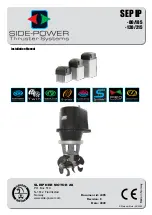
C002
Overview
www.ti.com
Figure 2. Optimized Sideband Suppression
1.4.1.3
Carrier Feedthrough
Carrier feedthrough is the amount of the LO that leaks onto the output spectrum of the modulator. Ideally
for the TRF370x, inputs (I, I, Q, and Q) must be at approximately 3.3 V for TRF370333, 1.5 V for
TRF370315, and 1.7 V for TRF370317 and TFR370417. The DAC dc settings are also useful to correct
the dc mismatch between I and I and between Q and Q to minimize the LO feedthrough. If using TI's
DAC568x, then the internal controls for the I/Q offsets provide excellent carrier suppression (very low LO
leakage). Alternatively, if an ESG is being used, adjust the I and Q voltage offsets in mV steps until you
obtain the minimum carrier feedthrough. A typical carrier feedthrough value exceeds –50 dBm. See
.
1.4.1.4
GSM (EDGE EVM Measurements)
1. Provide a GSM edge signal of the desired frequency into the differential baseband inputs (example
sample rate = 4.33 MHz).
2. Use a spectrum analyzer with edge personality to measure the transmit power to either 0 or –5 dBm.
3. PSA: Mode
→
GSM (with EDGE)
→
measure
→
Transmit Pwr (usually 0 or –5 dBm)
→
more
→
EDGE EVM.
4. ESG: Mode setup
→
select waveform
→
highlight EDGE
→
select waveform
→
ARB setup
→
type
4.33333 MHz
→
I/Q
→
I/Q output control
→
Common mode I/Q offset
→
(set to 1.65 V, 0.75 V, or
0.85 V, depending on device)
→
I/Q
→
I/Q output control
→
I/Q output atten (adjust to get desired
transmit power to either 0 or –5 dBm).
See
8
TRF370x Quadrature Modulator Evaluation Module
SLWU062 – March 2010
Copyright © 2010, Texas Instruments Incorporated






































